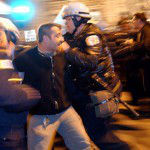By G. Flint Taylor
This article appeared in the March 11-18, 2013 edition of The Nation.
In Chicago, Black History Month is a time when some of us reflect on one of our poorest kept secrets, an ongoing injustice born of brutal, systemic racism, which has spread over a generation and whose stain is deeply embedded in the fabric of the city.
Forty years ago, a rookie Chicago police detective named Jon Burge tortured Anthony Holmes using electric shock and suffocation, causing him to crawl on the floor in pain. Lacing this torture with racial epithets, Burge initiated a pattern of dehumanizing abuse that would terrorize at least 120 African American men, their families, and the black community for the next 20 years. This pattern was marked not only by its uniquely brutal tactics, but also by its overtly racist motivation. Burge referred to his notorious electric shock device as the “nigger box,” routinely used the term “nigger” as part of his torture routine, and also used the term to describe his victims in boasting conversations with friends and even casual acquaintances. One day, when asked by an acquaintance about his work investigating homicides, he remarked that he had been “dealing with dead niggers all day.” His “right hand men,” Sgt. John Byrne and Detective Peter Dignan, also repeatedly used the term, including during interrogations, introducing the plastic cover used for suffocation by saying that they “had something special for niggers,” and threatening to hang another suspect by pointing to a noose hanging from the basement ceiling and saying they “hang niggers around here all the time.” Burge and his confederates often focused their torture and brutality on the genitals of their victims.
This blatant racism is highlighted by two pending civil rights damages lawsuits brought under the 1871 Ku Klux Klan Act, in which two wrongfully convicted torture survivors allege that their torture was the result of a racially motivated police conspiracy. In Darrell Cannon’s case, Byrne and Dignan informed him that they had “a scientific way to interrogate niggers,” then proceeded to take him to a remote area, and repeatedly electric shocked him on the genitals while using the racial slur so frequently that Cannon recalls thinking “that was my name.” In Ronald Kitchen’s case, Burge and detective Michael Kill beat him and kicked him in the genitals while racially taunting him. When later asked, under oath, how often he used the “n-word,” Kill proudly replied “more than a million times.”
Local historians, including African American history professor Adam Green at the University of Chicago, have linked this racially based torture to the brutality of slavery, lynchings, and Jim Crow. The parallels in the nature and focus of the brutality are undeniable. So too the selection of African American commanders chosen for their subservience who looked the other way when they heard the anguished screams of the torture victims, and actively participated in the cover-up. African American detectives were kept in line by strict enforcement of the police code of silence, and when they complained of Burge’s racism to their Commander, Burge threatened them with retaliation. Several of these detectives heard rumors that Burge was a Ku Klux Klan member in Indiana. So black detectives under Burge remained silent, coming forward to acknowledge the “open secret” only when they retired decades later.
The CookCountyprosecutor’s office not only countenanced and facilitated the racist pattern of torture; it also aggressively used the confessions so produced to wrongfully convict scores of African American men, sending a dozen to death row. Some of these prosecutors kept a scorecard of their “accomplishments,” comparing the weights of their convicted defendants in a competition called “nigger by the pound.”
Richard M Daley’s long term involvement in the torture scandal is now well known. As Mayor he scorned all opportunities to apologize, and paid millions of public dollars to continue to defend against this undeniable record of racism. In 2006, special prosecutors given $7 million in public monies to investigate Burge and his men, somehow managed never to mention the racist nature of the torture in their 192 page report. And when Burge was finally put on trial in 2010 — not for the torture itself but for lying about it — his lawyers successfully kept any mention of racism out of the record. While waiting for the jury to return a verdict, Burge asked a courtroom observer whether the jury would really “believe that bunch of niggers,” apparently referring to the courageous men who had testified against him. One of those men was Melvin Jones, to whom Burge rhetorically posed a similar question while torturing him with electric shocks 30 years earlier.
Last summer the Chicago City Council and Mayor Rahm Emanuel signed off on a settlement for another torture survivor, Michael Tillman, who was exonerated in 2010. It was the perfect chance for the mayor to apologize on behalf of the city to the African American community that helped elect him. He chose not to do so. Instead, picking up where the Daley administration left off, the mayor has continued to fund Burge’s defense, paying private lawyers a total of $3.8 million to date in the Cannon and Kitchen cases alone. Incredibly, in the Kitchen case, the lawyers the Emanuel Administration has chosen to represent Burge are the very same lawyers a federal judge has found to have practiced “deliberate,” “purposeful,” and “invidious” “racially based” discrimination during jury selection in another wrongful conviction case.
Burge is now serving a four-and-a-half-year sentence in federal prison, where he continues to receive his pension on the taxpayers’ dime. None of his co-conspirators have been held accountable. At the same time, scores of torture survivors remain locked behind bars, serving significantly longer sentences for crimes to which they confessed while being brutalized. If Black History Month is to mean anything in a city like Chicago, our leaders must finally own up to this racist legacy—or they, too, will be remembered for covering it up.

